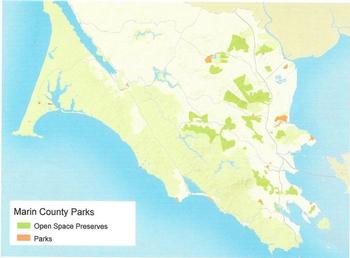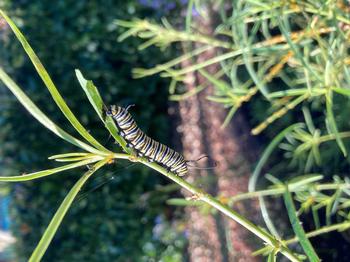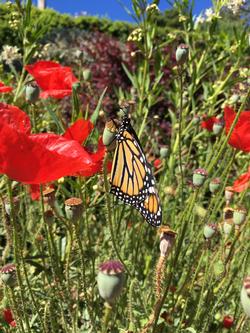Build a wildlife corridor to support monarch butterflies
-
Alice Cason
-
A wildlife corridor is a continuous swath of natural and agricultural lands. It is an area of habitat that connects wildlife populations separated by human-built structures like roads, and housing developments due to urbanization. These corridors are critical to maintain the quality of our water, forests, and wildlife. Corridors create continuous habitat for certain animals, birds, and insects. They fulfill their needs for water, rest, and food. Marin homeowners can make a difference by developing their landscapes to connect the larger wildlife corridor around them.
 Map of Marin County Parks and Open Space Preserves showing 85% of the land protected from development. Photo: National Park Service
Map of Marin County Parks and Open Space Preserves showing 85% of the land protected from development. Photo: National Park ServiceOne of the many species that migrate through my garden is the Western Monarch Butterfly (Danaus plexippus). They migrate from the Rockies to some 400 overwintering sites along the coast in California including some 18 along the coast in Marin County near Bolinas, Stinson Beach and Muir Beach. During winter the butterflies conserve their energy in a state of diapause. With environmental cues like increased daylight and warmer temperatures they know when it is time to leave the overwintering grounds on their way east and north.
The monarchs time their arrival in early spring to mate where their host plants, the milkweeds (specific Asclepias species) are growing. In my garden I have planted many monarch host plants where they lay eggs, hatch as caterpillars, turn into chrysalis and then emerge to continue their journey north. It may take several generations to reach their destination, and several more to return in the fall to their winter quarters. A monarch caterpillar enjoys native narrow leaf milkweed. Photo: Alice Cason
A monarch caterpillar enjoys native narrow leaf milkweed. Photo: Alice CasonHost plants are vital to their 4 stage life cycles of egg, caterpillar, chrysalis, and butterfly. They will only lay eggs on their host plant, milkweed. There are two milkweeds native to Marin County, Asclepias fascicularis (narrow leaf) and also Asclepias speciosa, (showy milkweed) that help feed Monarchs.
We need nectar plants support the adult Monarchs. Unlike the munching caterpillar, the butterfly is born without a mouth. It has a long proboscis to get nourishment. It is important to include a variety of nectar plants that bloom at different times of the year with clusters of flowers like those in the aster and mint families.
The Monarch population is in jeopardy due to destruction of overwintering sites, urbanization, wildfires, decrease of habitat, and the use of pesticides. Landscapes that enhance biodiversity are more resilient to pests, diseases, and the effects of climate change. Use the least toxic methods of pest management and rely on the natural systems that exist. Avoid the use of pesticides that can harm wildlife. A Monarch Butterfly enjoys nectar on the way through Marin County. Photo: Alice Cason
A Monarch Butterfly enjoys nectar on the way through Marin County. Photo: Alice CasonThe U C Marin Master Gardeners have plant lists on their website http://marinmg.ucanr.edu to help homeowners select plants that are attractive, easy care, water wise and pollinator friendly. California natives can add a functioning ecosystem in your garden. There are also lists for other species of butterflies and native insects which form the base of the food chain upon which all wildlife depend.
You can help by removing invasive plants. Unfortunately, “scorched earth” or excessive clearing provides a vulnerable entry point for the plants we do not want. Many of those are flammable and prevent our native plants from succeeding. Replace invasive plants with suitable California native vegetation.
Do you have a water source for butterflies? They like muddy puddles with sand. By sipping moisture from mud puddles, butterflies take in salts and minerals from the soil. This behavior is called puddling.
Marin County has 85% of the land protected from development. Preserving our natural assets are 39 County parks, 34 Open Spaces, 6 state parks (including Angel Island} and 20,000 acres of protected watershed. The Golden Gate National Recreation area encompasses 82,027 acres of significant landscapes in the Bay Area including the Marin Headlands at the entrance to our county. Make our Earth-friendly gardens a part of this dynamic landscape.
For more information on how to help the monarch butterfly visit go to https://www.xerces.org/.



